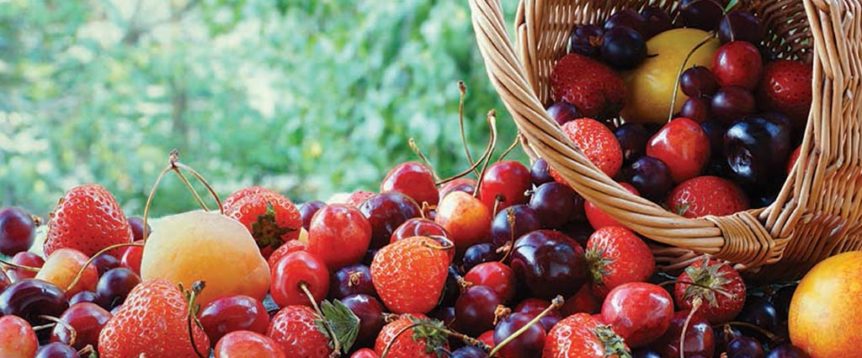Not so long ago our ancestors depended on the bounty of the seasons to fill their plates. Diets consisted of what could be grown, foraged or hunted. Every season offered valuable contributions to the larder. Now we have the luxury of visiting the nearby grocery store to stock our pantries with just about anything desired at any time. But there is more to eating seasonally than just convenience; a seasonal diet is also connected with the harmonic nature of your overall health, your body and your internal organs.
According to John Douillard, D.C., C.A.P.—a natural health, Ayurveda and sports medicine practitioner based in Boulder, Colo.—seasonal eating has the potential to fulfill three “best-selling” diets—each for four months of the year. “There is a low-fat spring harvest of bitter roots and leafy greens, a high-carb summer harvest of fruits and veggies, and a high-fat/high-protein fall harvest that stores easily for a long, dormant winter,” he explains. If we follow a more natural approach to our diet by eating active harvests during spring, summer and fall, he adds, we should be able to meet most of our nutritional needs.
Douillard contends that seasonal eating benefits organ health, too. A basic tenet of traditional Chinese medicine is that each season is associated with a color related to the types of foods eaten (green for spring, for example), as well as specific body organs and a specific taste that stimulates the organs. In short, he explains, our bodies are connected to the rhythms of seasonal cycles, so eating with the seasons is a natural method of maintaining, detoxifying and strengthening the body and its organs. And if we aren’t eating the right foods at the right time of year, an imbalance (or sickness) can happen. Take a look at the chart “Seasonal Eating for Your Organs and Health” for common imbalances and the foods you can eat each season to counter them.“Preparing foods seasonally is linked to the changing of our digestive strength, which takes place each season,” Douillard says. Winter is traditionally a time to slow down, and meals consist of warm, hearty stews, broths and soups with root vegetables. This feeds the kidneys, which in turn create nutrients for bone health. In contrast, the rejuvenating qualities of spring compel us to go outside into the warming sunshine and enjoy a diet rich in fresh spring greens, which detoxify and cleanse the liver.
As a professional athlete years ago, Colleen Cannon, founder of Women’s Quest health and wellness adventure retreats, discovered the benefits of a seasonal diet at the suggestion of her coach. Cannon says by following a seasonal diet she was able to win world and national triathlon titles. “I slowed down in winter to build energy for the training of spring, which enabled me to bloom during the summer racing season and harvest my growth and reseed in the fall.”
Now at age 55 and retired from racing, Cannon is still active, and she’s found that seasonal eating is helping her through menopause. “When you follow the seasons, you listen to your body and the organs involved with each season,” Cannon says. “I’ve learned to eat what makes me feel good year-round.”
Spring
Color: Green | Organs: Liver and gall bladder | Symptoms of imbalance: Eye and skin problems, allergies, cracked nails, dull muscle and tendon pain, menstrual problems
Foods of the season: Eat fresh, lightly prepared greens. Spinach, chard, parsley, romaine lettuce, collard greens, kale, sprouts, seaweed, celery, chives, carrots, asparagus, broccoli, radishes, raspberries, strawberries, grapes, grapefruit, black beans, chicken, turkey, shrimp, chicken, eggs
Summer
Color: Red | Organs: Heart and small intestine/Late Summer: Spleen and stomach | Symptoms of imbalance: Heartburn, poor memory, nervousness, insomnia, red complexion, bloating, sluggishness
Foods of the season: Eat more raw foods and fresh fruit. Watermelon, apricots, peaches, cantaloupe, cucumber, bok choy, oranges, tomatoes, broccoli, corn, spinach, watercress, summer squash, mint, dill, cilantro, fish
Fall
Color: White | Organs: Lungs and large intestine | Symptoms of imbalance: Respiratory ailments, dry skin, negativity, constipation, digestive issues
Foods of the season: Cut back on raw foods; eat more slow-cooked foods and soups. Sweet potatoes, onions, cabbage, mustard greens, garlic, leeks, bananas, plums, limes, lemons, apples, ginger, pears, eggs, yogurt, cheese, navy beans, soybeans, pork, walnuts, almonds, cinnamon, cardamom
Winter
Color: Black | Organs: Kidneys and bladder | Symptoms of imbalance: Excess fear or stress, dehydration, bone issues, fatigue, insomnia
Foods of the season: Slow-cook soups, broths and stews. Black beans, kidney beans, squash, potatoes, root vegetables, winter greens, carrots, celery, endive, escarole, cabbage, mushrooms, apples, pears, lamb, chicken, walnuts, seeds, roasted nuts, quinoa, oats, rye, barley, millet

